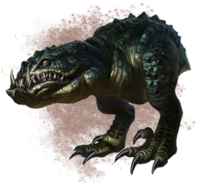| Alits | |||
|---|---|---|---|
 An Alit
An Alit |
|||
| Type | Beast (Reptile) | ||
| Range | Black Marsh, Elsweyr, Morrowind, Valenwood (invasive) Hunting Grounds |
||
| Appears in | |||
Alits (or Dusky Alits)[1] are tailless, bipedal omnivorous reptiles that are native to Morrowind and Black Marsh.[2][3] They also inhabit parts of Elsweyr, such as the island of Khenarthi's Roost,[4] and a species of brown Desert Alits live in Northern Elsweyr.[5][3] Alits can also be found in Valenwood, though they are not native to the region. Animal enthusiasts from Valenwood used to import the creatures. A good deal of them escaped captivity, and now alits roam the southwestern forests.[6] They are related to guar, kagouti, and wormmouths.[6][7]
Behavior and DietEdit
Built like the kagouti, the Alit has a large head and protruding jaw, and when running on its short, stumpy legs, it looks like a big toothy mouth with feet.[8][4] While they lack the stature of their kagouti cousins, they possess a more vicious temperament and more cunning attack instinct.[9] They attack by biting and can jump deceptively high.[4]
They are solitary creatures, and prefer easy prey such as sheep.[4] They are known to eat the 'meat-husks' left behind when a nix-hound drains their prey of bodily fluids.[10] Though sometimes impatient alits will fight with nix-hounds over a fresh kill.[UOL 1] Like guar, they also supplement their nutrition by rooting.[6] Alits are known to carry diseases such as ataxia,[11][2] black-heart blight,[2] and rockjoint.[1]
UsesEdit
Alits have tough skin and chewy meat,[5] and their hides make a serviceable multi-purpose leather.[12] The Ashlanders value their tanned hides highly,[9] as they make use of them as trade goods.[12] The material has applications for armor crafting and alchemy.[13][14]
GalleryEdit
See AlsoEdit
- For game-specific information, see the Morrowind, Elder Scrolls Online, and Legends articles.
ReferencesEdit
- ^ a b Rockjoint description in Morrowind
- ^ a b c Alits in Morrowind
- ^ a b Alits in ESO
- ^ a b c d Bolga's Guide to Island Beasts — Bolga gra-Bur, Huntswoman of Mistral
- ^ a b Anequina Animal Identification and Tasting — Hrodkir Mincemeat
- ^ a b c Morrowind Fauna, Part One — Holia Asellio
- ^ Esqoo of Dhalmora Answers Your Questions — Esqoo of Dhalmora
- ^ Generic dialogue on the topic of Alit in Morrowind
- ^ a b Kyne's Challenge: A Hunter's Companion — David S. J. Hodgson
- ^ Nix-Hounds: A Manual for New Owners
- ^ Veenaza's dialogue in ESO
- ^ a b Generic dialogue on the topic of alit hide in Morrowind
- ^ Alit Hide in Morrowind
- ^ Crafting Motif 44: Silken Ring Style — Bathed-in-Steel, First Armorer of Stormhold
Note: The following references are considered to be unofficial sources. They are included to round off this article and may not be authoritative or conclusive.
- ^ Ted Peterson's posts in Playing Houses